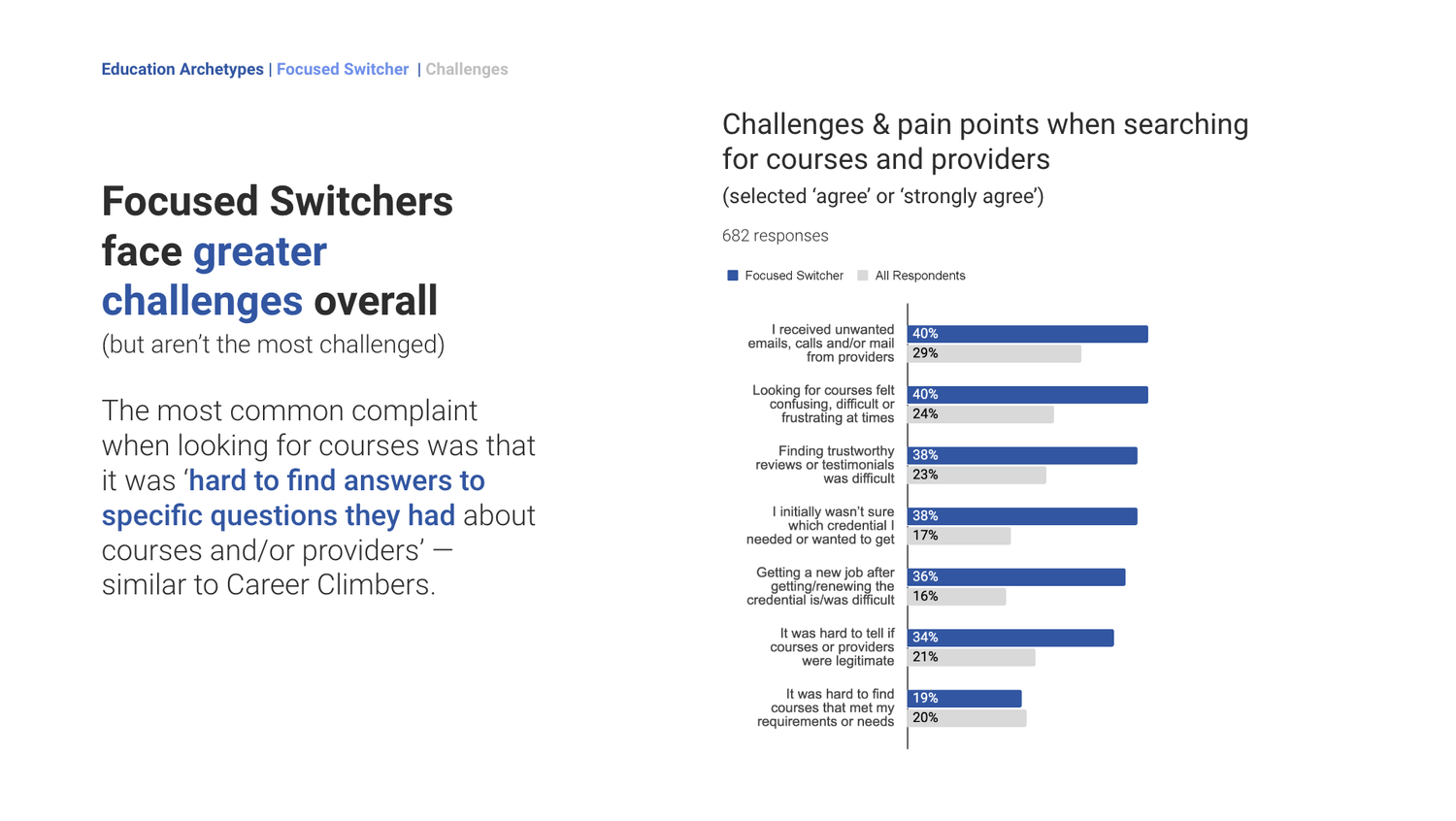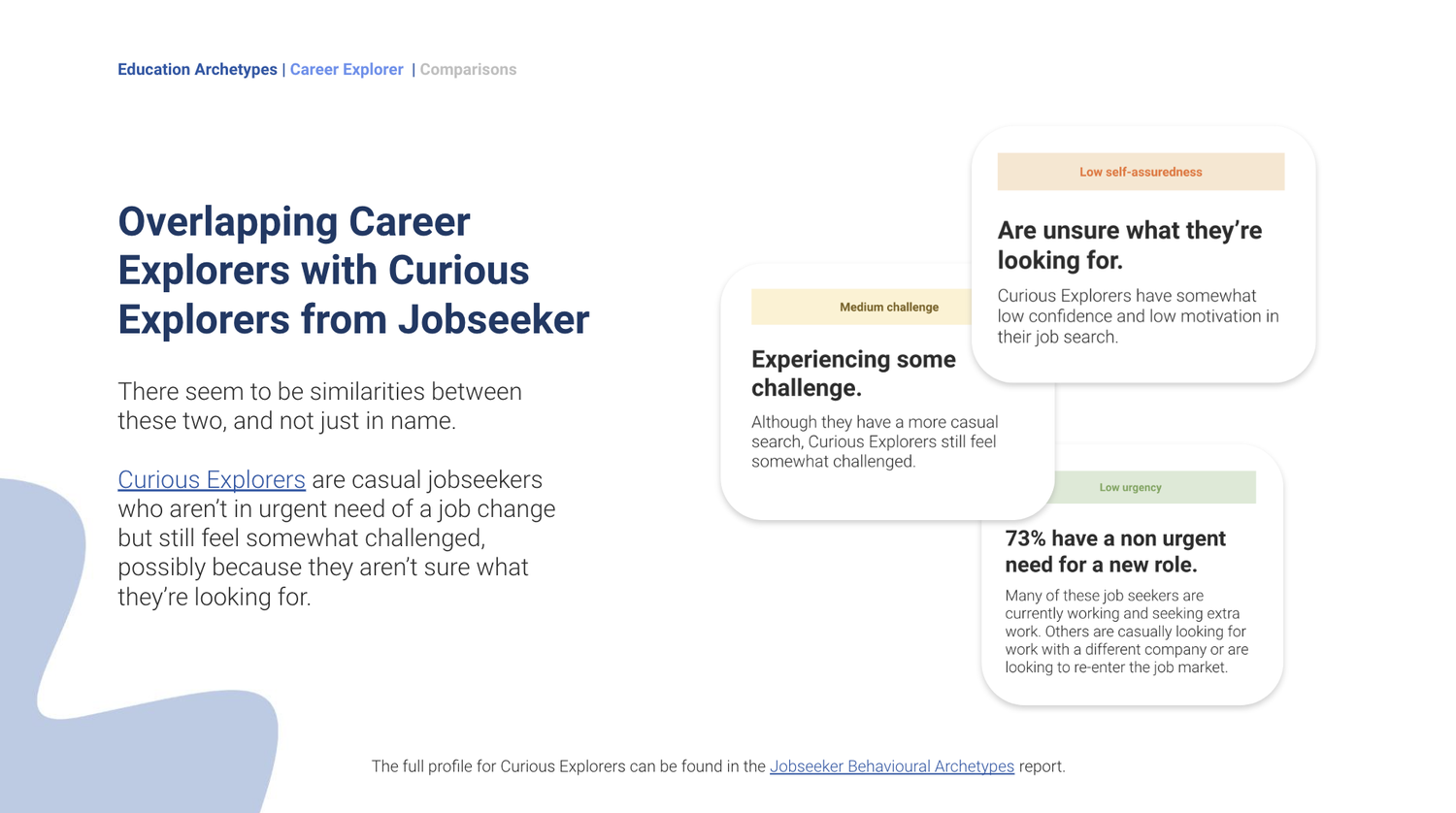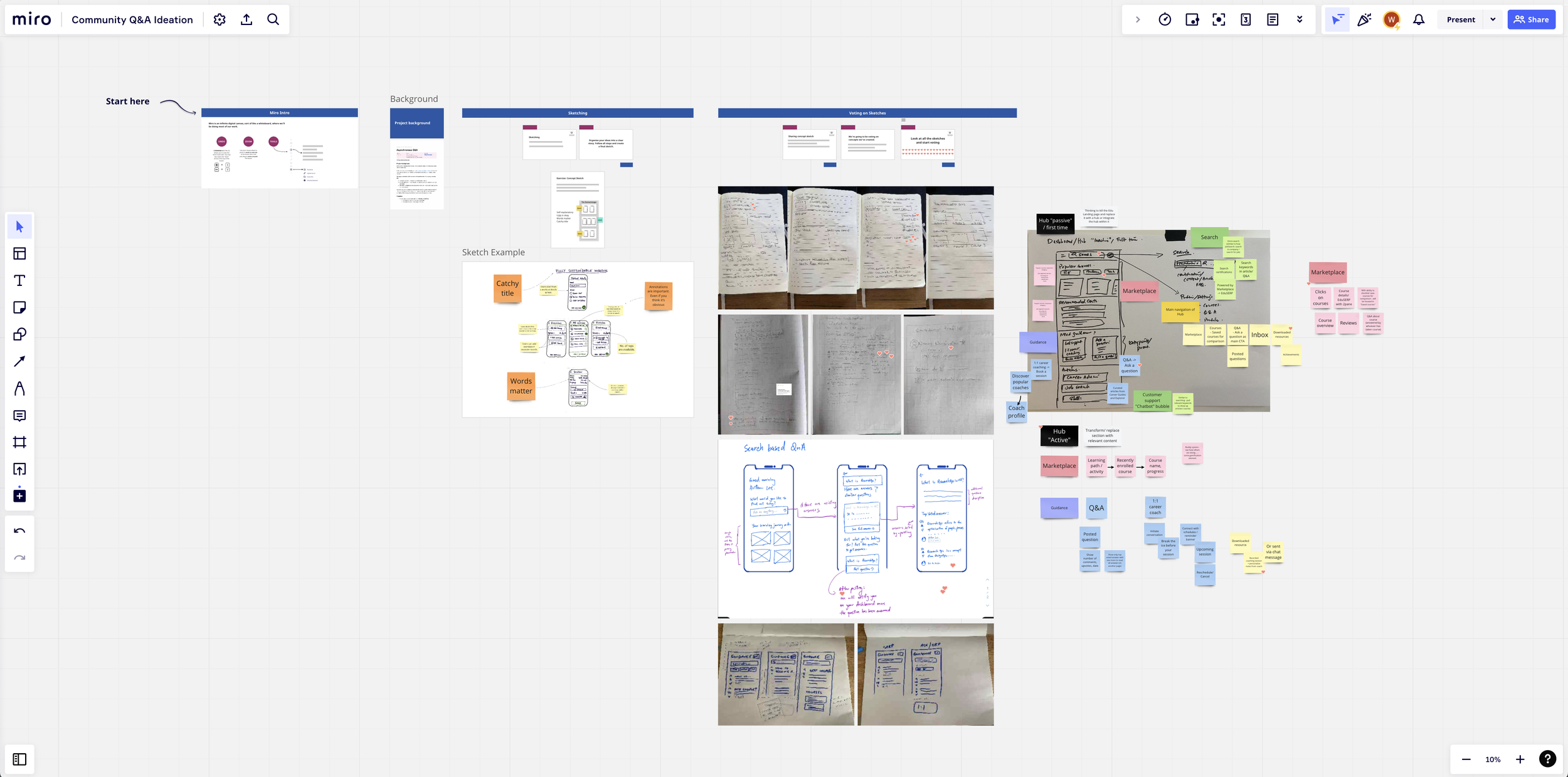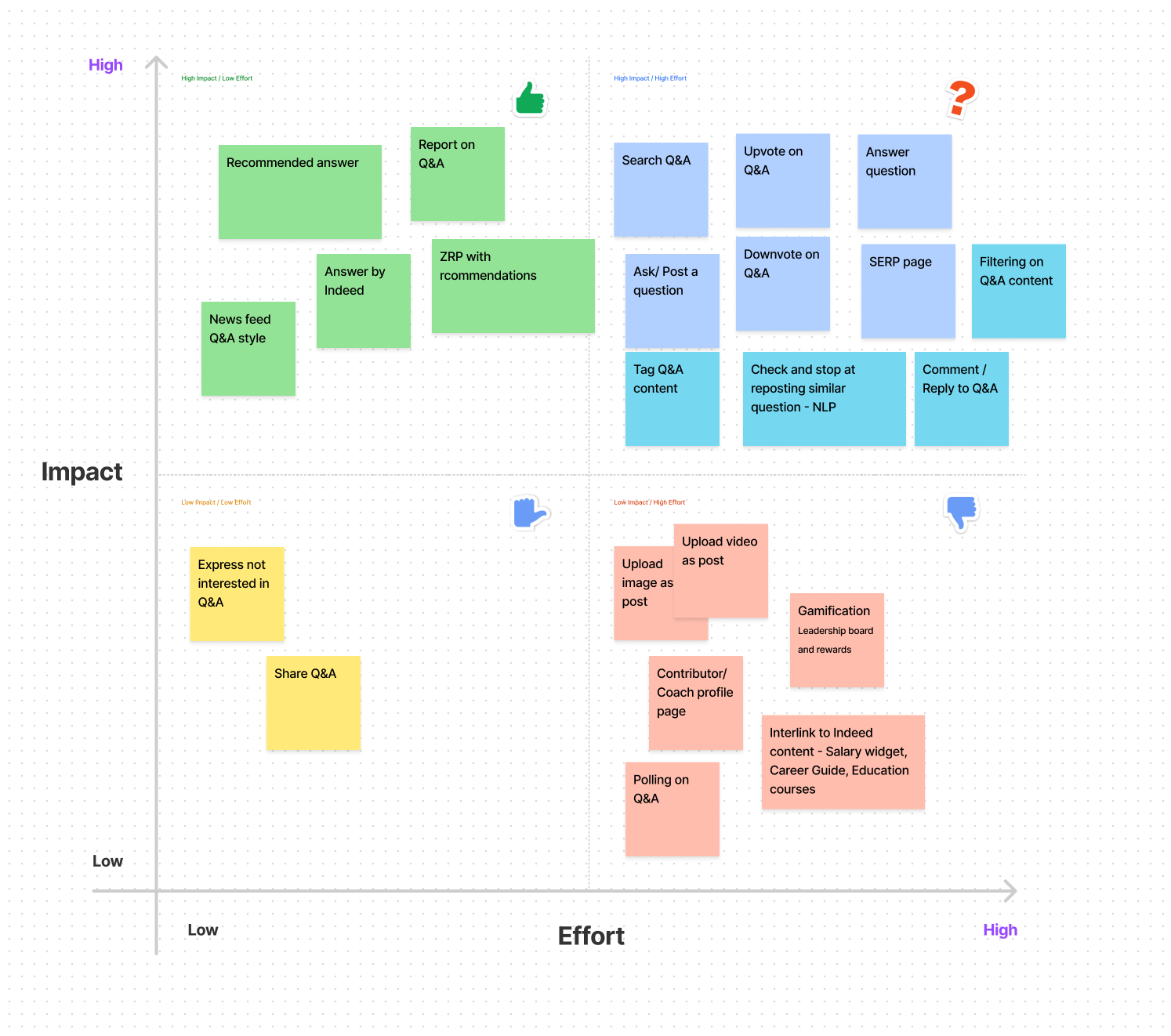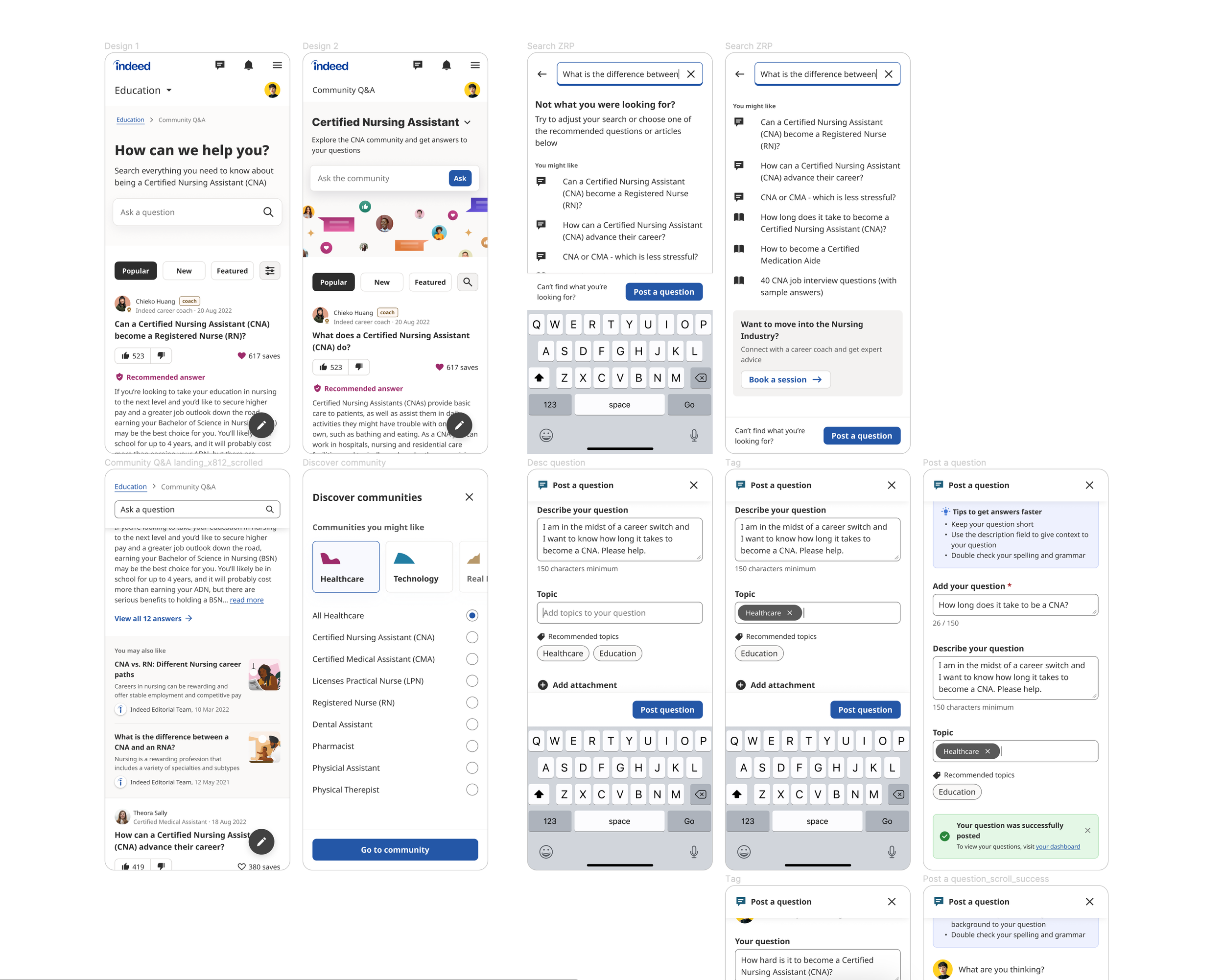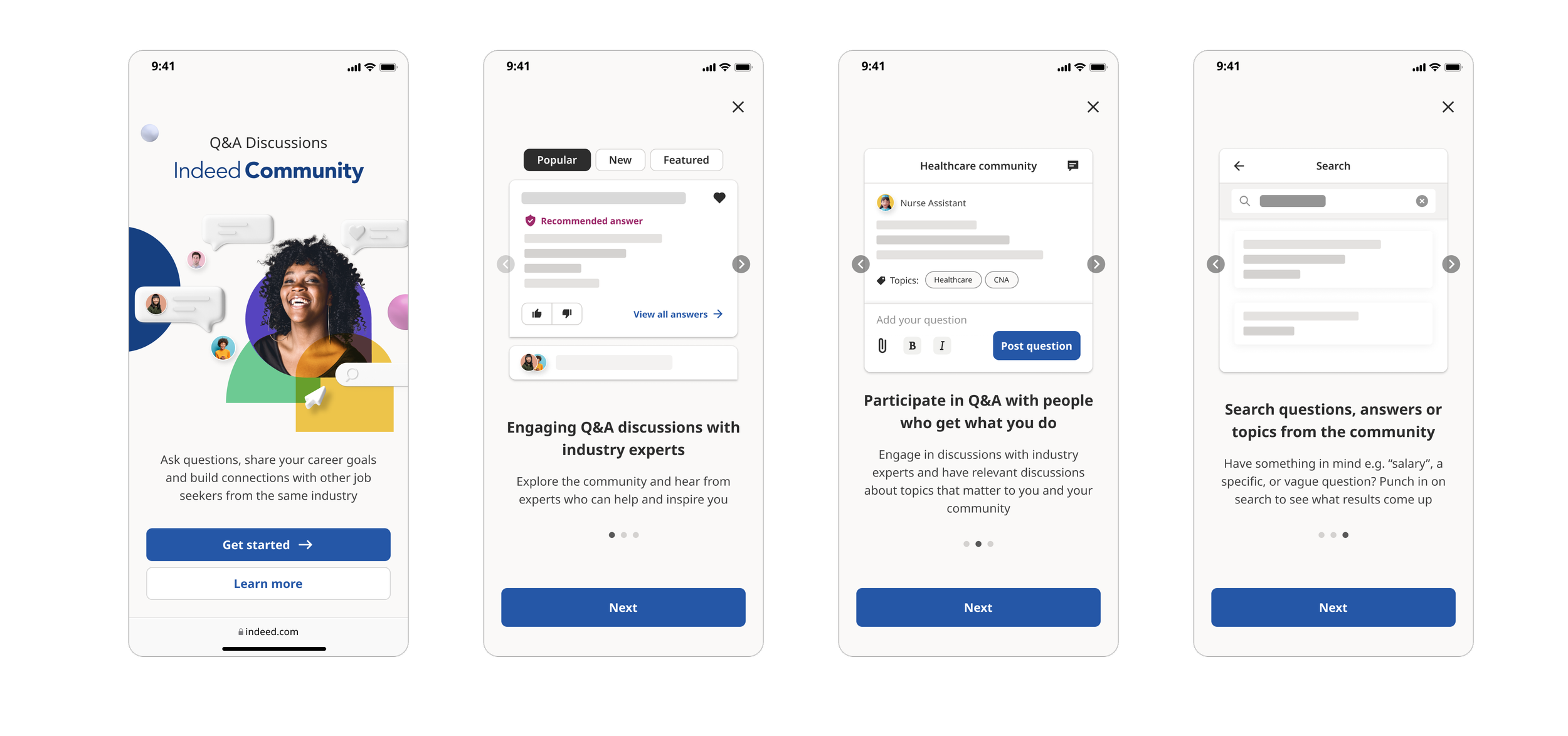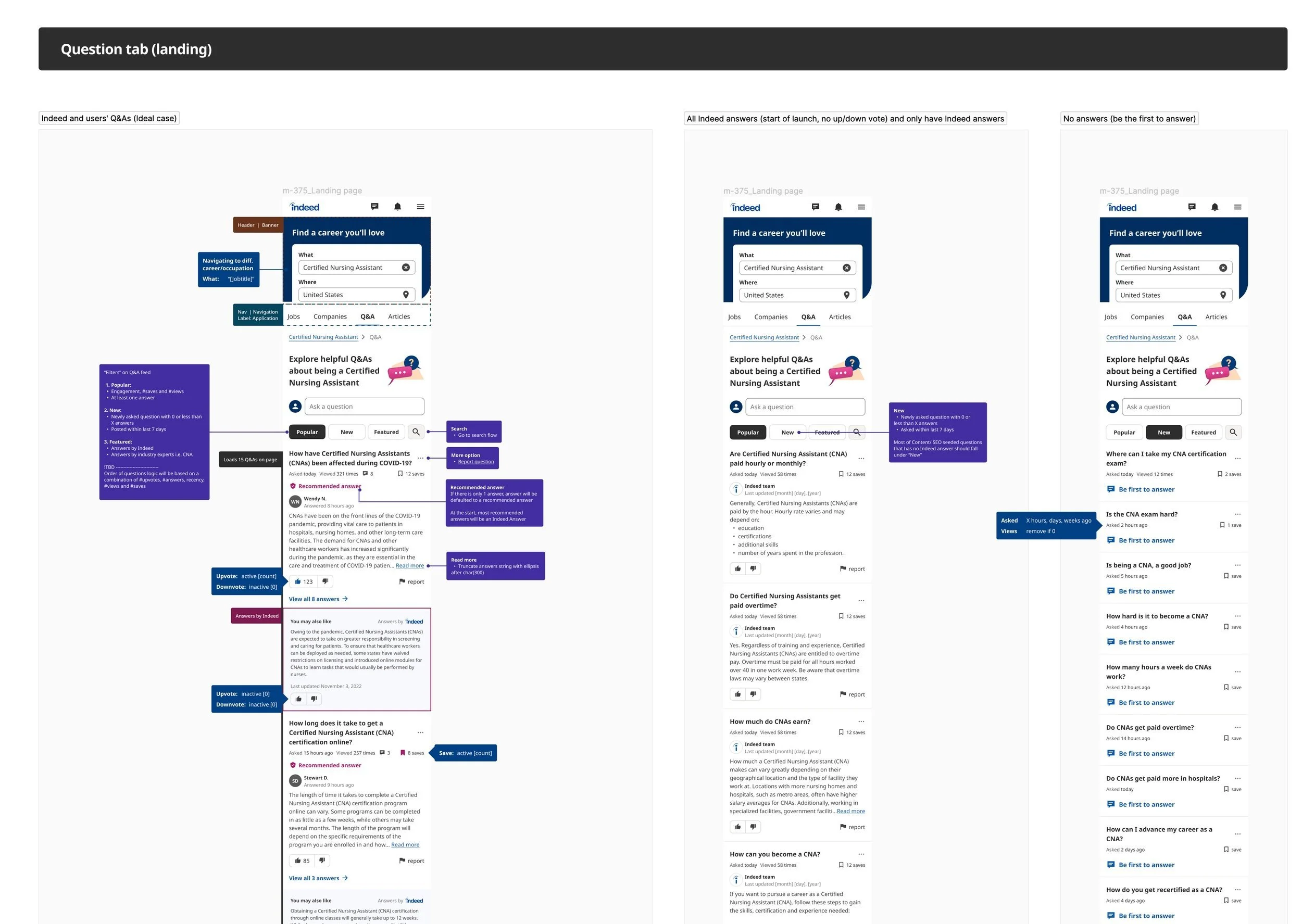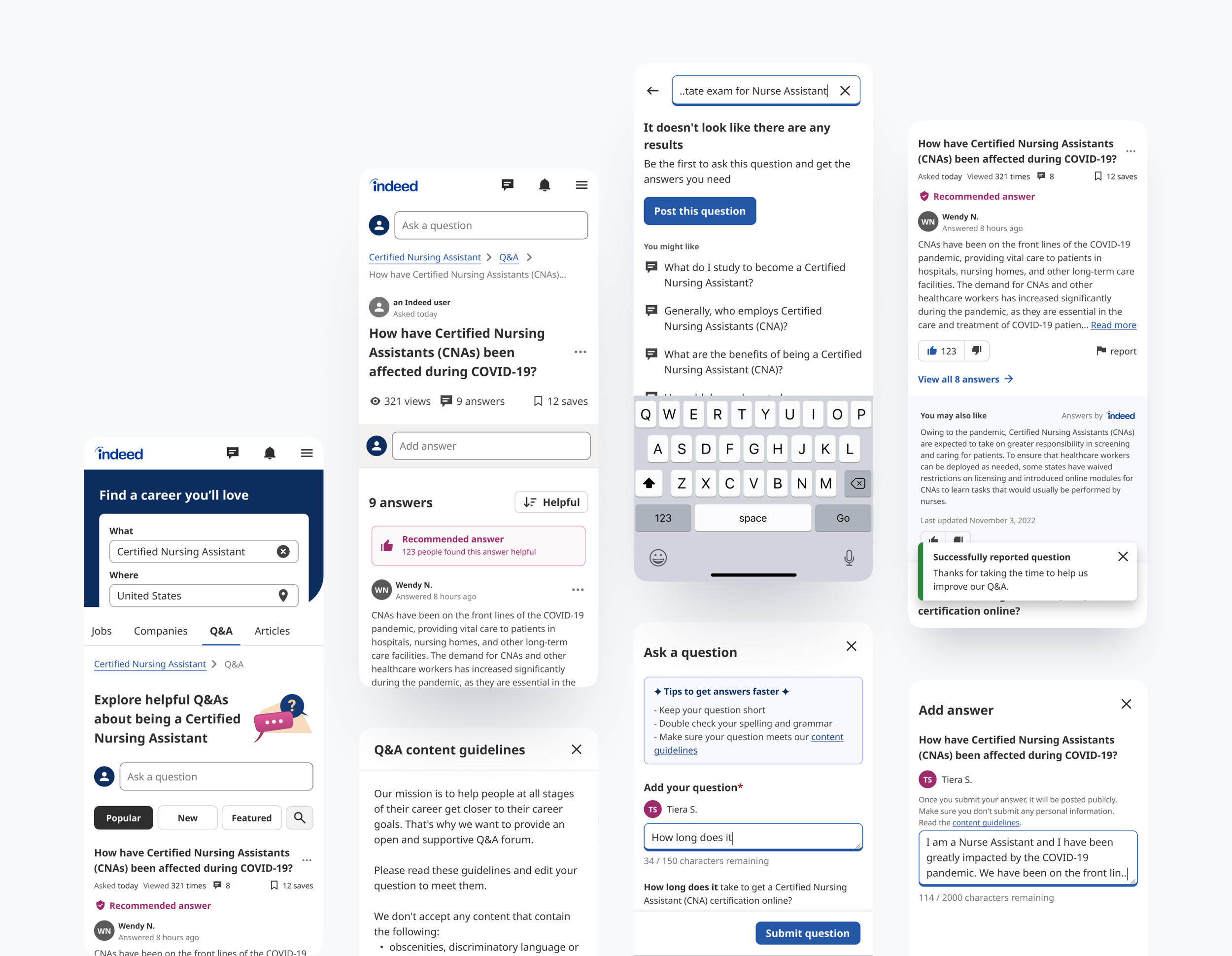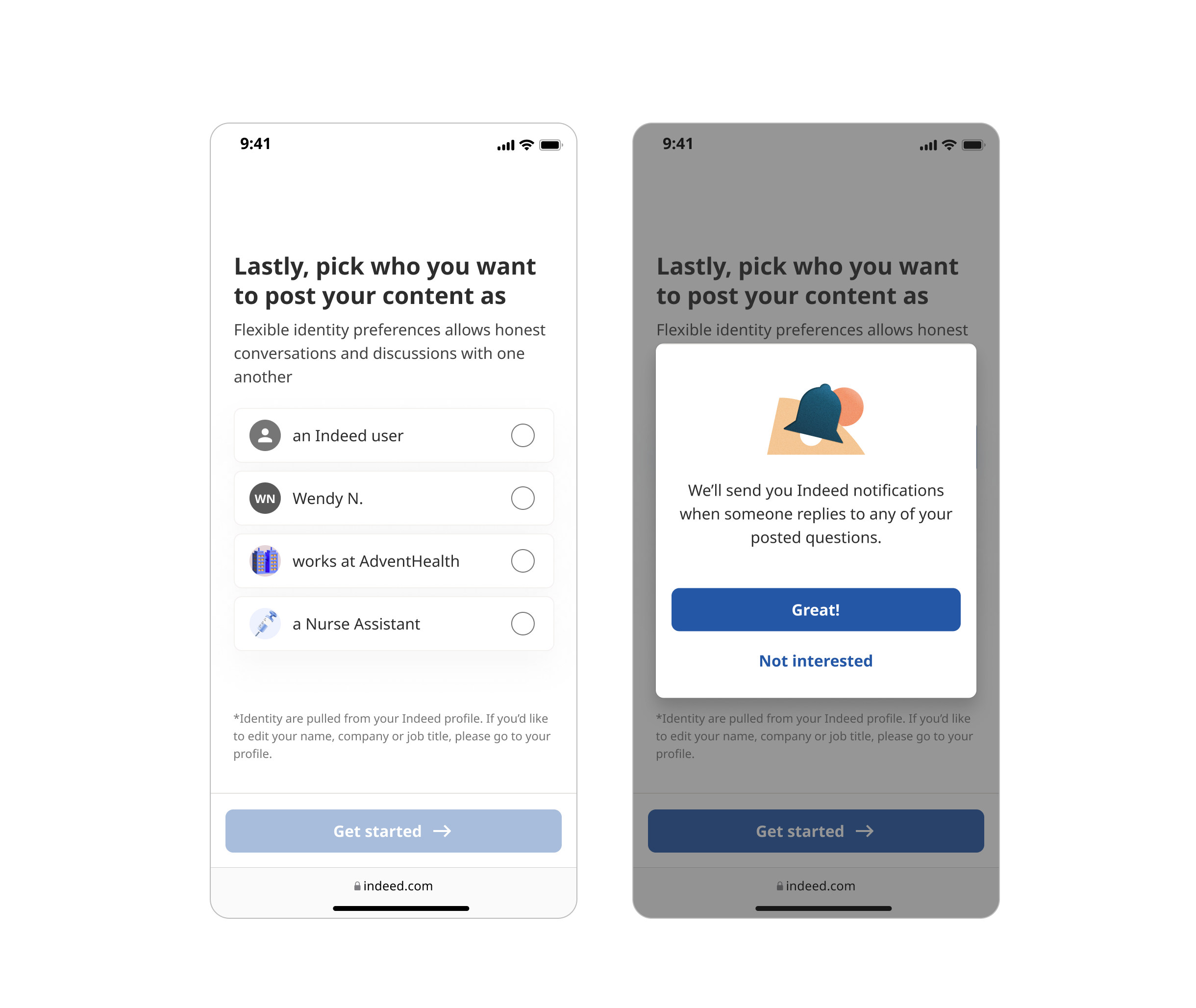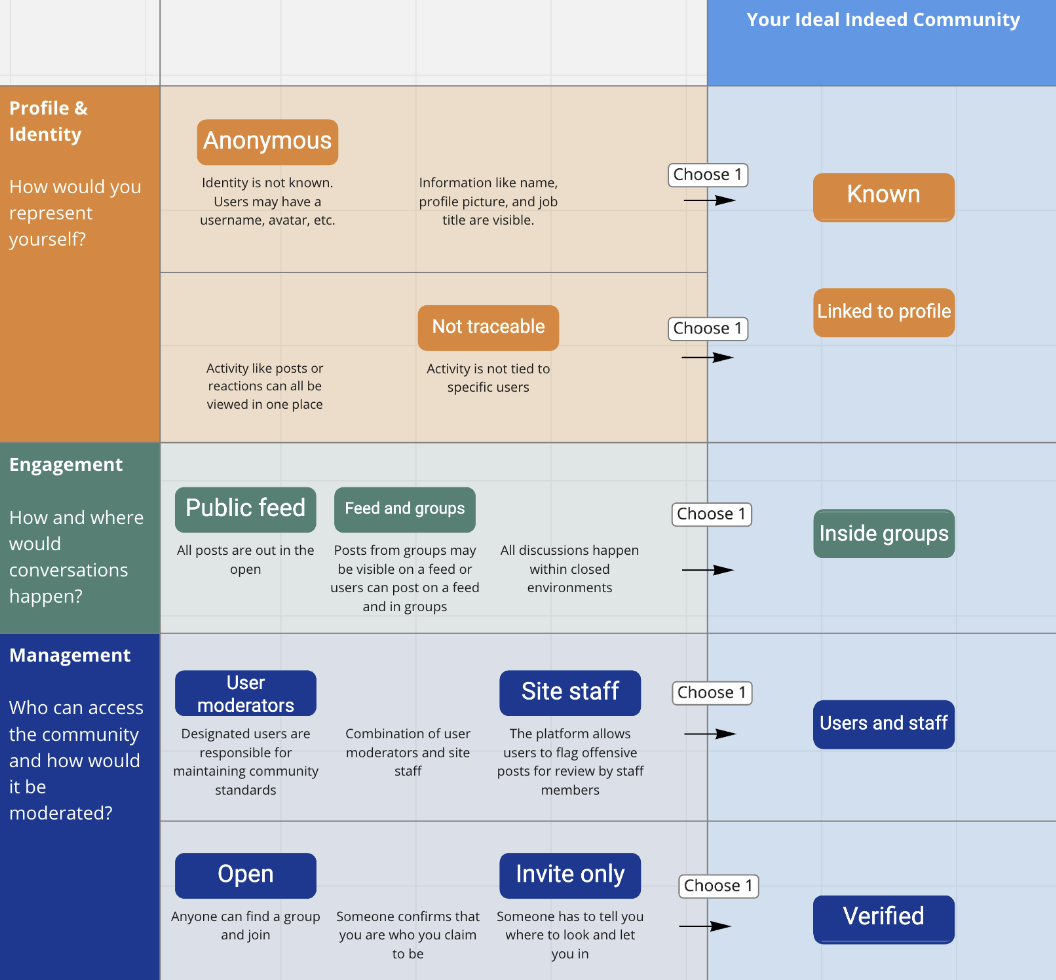Indeed Community —
Engaging Q&A Discussions with Industry Experts
Project
Community Q&A PlatformMy contribution
As the UX Lead for Indeed Education (Discovery Team), I led the work on UX strategy, UXUI design, prototyping, and data analysis to measure the service’s impact and identified areas for improvement. Skills/ Expertise
User Research, Competitive AnalysisUX Strategy, Design Thinking, User Experience Design, Prototyping, Data AnalysisTimeline/ Duration
Oct 2022 to Jan 2023
Tool
UserTesting, Miro, FigmaOverview
Indeed connects millions with job opportunities, yet there's a gap in providing the human connection and support crucial for those seeking not just jobs but also career guidance and development. Both job seekers and current workers need access to coaches, industry experts, and a supportive community to navigate their unique career paths and tackle individual challenges.Background
The Education North Star vision aims to provide a comprehensive end-to-end support for workers, including personalised career recommendations, expert guidance, education resources, and job matching services, all consolidated into a single, accessible platform.
This project zeroes in on the. Community Q&A platform, a central part of the North Star vision's expert guidance initiative. Its main aim is to foster a supportive community where workers can engage with other peers, exchange tips, and gain useful knowledge and career advice through content created by users.
Additionally, the Career Coaching service is also part of the expert guidance initiative, offering workers expert career advice and support through a 20-minute video call. The Community Q&A and the 1:1 Career Coaching services will differ in several key ways:
Interaction format
Community Q&A: Interaction is primarily text-based, with workers posting questions and receiving answers from the community.
1:1 Career Coaching: Interaction is personal and direct, taking place through a 20-minute video call with a career expert.
Scope of advice
Community Q&A: Offers a wide range of perspectives and experiences from various community members, covering diverse topics.
1:1 Career Coaching: Provides specialised, tailored advice focused on the individual's specific career goals and challenges.
Anonymity and Privacy
Community Q&A: Users can choose to ask questions anonymously, sharing as much or as little personal information as they prefer.
1:1 Career Coaching: Sessions are private and confidential, with personal interaction between the worker and the coach.
Cost structure
Community Q&A: Typically free, relying on voluntary participation from the community.
1:1 Career Coaching: Usually a paid service, providing personalised guidance from a career professional.
Defining The Problem
Workers encounter a range of questions and concerns at different stages of their career transition journey
Problems faced can be broken down into three major phases:
Exploring careers
Exploring new career options is often accompanied by feelings of uncertainty, reduced motivation, and a lack of confidence. Successfully navigating this transition demands considerable time, dedicated effort, and effective guidance.Figuring out what is required to reach Career B
During this phase, workers often face an overwhelming amount of information, a high level of uncertainty, and numerous questions. Consequently, they require extensive guidance, support, and motivation to make informed decisions and successfully undertake their upskilling journey.Finding jobs
Workers encounter obstacles such as securing appropriate entry-level positions or landing interviews, often hindered by a lack of experience in the desired role. Additionally, they grapple with preparing for interviews, crafting compelling resumes, and other pivotal aspects of the job application process.What Have We Learned?
Our research indicates that most users initially seek advice and answers from their personal network, comprising friends, family, and colleagues. Once they've utilised this resource, they then resort to online platforms for further opinions and insights. Notably, there's a strong preference for information from credible and trusted sources, such as individuals with industry experience, over generic articles or content from less familiar websites or unknown entities.
Some Career Switchers embark on their journey after being inspired or informed by someone in their personal network who is already established in the desired career field. This connection often provides them with valuable insights, answers to their questions, and information, influencing their decision to pursue a new career path.
Personal networks can play a significant role in career switching journeys
“I asked my friend in the IT industry what I could take to upskill and he told me to take on web development as it pays well to be a Software Engineer”
Vaughn, a data administrator feeling stuck in his role. He’s considering signing up for an intermediate-level coding bootcamp in order to expand his work scope because his friend told him to.User Stories & HMWs
Unpacking key user stories and how might we
Recognising the pain points of Career Switchers, I crafted user stories and corresponding 'How Might We' (HMW) statements. These elements are strategically designed to guide and shape the development of our community Q&A platform, ensuring it aligns with the needs and challenges of our users.-
How might we support workers in conducting self-directed research and learning about their career options, as an alternative to 1:1 career coaching?
-
How might we create a community where Career Switchers can connect with individuals who have successfully navigated a career switch, as well as with industry experts (coaches and mentors), to receive advice and guidance in making informed decisions about their career options?
How might we design and maintain an online community-space that prioritises transparency, data privacy, and open communication, to foster trust and credibility among its users?
-
How might we design an activity feed that displays Q&As in a user-friendly and accessible format, allowing workers to browse content easily and be inspired to come up with their own new questions?
How might we create a tool that helps workers explore and compare different careers, especially if they have no idea what career is best suited for them?
-
How might we design an activity feed that displays Q&As in a user-friendly and accessible format, allowing workers to browse content easily and find fast and accurate answers to their questions?
How might we create a search function that allows users to quickly and easily search for relevant content on-site, improving the accuracy and speed of their searches?
How might we design a navigation system that makes it easy for users to find content by browsing or navigating, improving the overall user experience and making it easier for users to find relevant information?
How might we optimise our pages for search engines, making it easier for users to land on relevant pages and find the information they need quickly and easily?
Shaping Our Product Strategy
💡
Many of these users seek fast and accurate answers, and a community-driven Q&A platform can help them make progress, if product is made available to them
Comparative Research
Learning from existing solutions out there
Many workers and job seekers rely on communities to help them in their careers, whether it's finding a new job, networking, or getting advice. These communities can be professional networks, industry forums, or social media groups where people discuss jobs, careers, and industry trends.
I explored these communities to understand how they impact people's careers and to find opportunities that could benefit workers and job seekers. This involved diving into these spaces, observing the discussions, and learning what makes them valuable for professional growth and connection.In my quest to understand the dynamics of work-related interactions and the role of communities in professional development, I explored a diverse range of platforms where such conversations take place.
01
Communities aspects —
I wanted to delve into the different dimensions and characteristics that define these communities. What makes them tick? What features or aspects are most valued by their members?02
Where are people going today, and why? —
I was interested in discovering the current popular platforms or spaces that people frequent. More importantly, I wanted to understand the reasons behind these choices and what draws people to these particular communities?03
Demographics, who and who is not? —
It was important for me to learn who is actively participating in these communities and, conversely, who is not. What are the common traits or characteristics of these active members, and what barriers might be preventing others from participating?Communities Landscape Audit
I noticed a few important things that caught my attention.….
01
Screen-based work: Is it easier for people who primarily use computers for their jobs to switch between work and communities?Computer literacy: Are people in specific roles more or less likely to be tech literate?Identity-based roles: Are individuals in certain roles more likely to consider their work part of their identity and want to discuss it outside of work?Work environment: Do people working in more isolated environments tend to seek out online communities?“Screen-based” occupations seem to dominate the space
02
People are drawn to platforms for various reasons before they discover or join work-focused communities. These reasons include:Keeping up with friends and familyNetworkingLooking for a jobAppeal of private conversationsWork platforms being repurposed
Work-related communities exist where people are
Communities with highly specific or niche topics, like "Amazon Warehouse Associates," tend to have more active discussions. In contrast, broader or vague topics like "Warehouse Jobs" may have less engagement or outdated information.Additionally, some highly specific communities may have stringent verification processes to access their content.Narrower topic spaces seem to lead to more interaction
03
Each platform and community employs unique methods to build trust.The level of anonymity or transparency in a community appears to shape the nature of discussions among its members.Trust is vital for communities to flourish
04
Reserch Discovery
I uncovered several key components that contribute to the makeup of a community:
User roles and
Profiles
Who is on the community and how public or private their information is
Engagement
How users interact and have back-and-forth
Management
How users are able to access the community and how the platform is moderated
Audit is by far just an observation.
There are things we can and can’t learn from it
During my exploration of the potential for an Indeed Community for work-related topics, I recognised the significance of conducting comprehensive research to uncover critical insights about user behaviours and preferences. To gain a deeper understanding, it is essential to engage in interviews and analyse user data, allowing us to address fundamental questions.
And by doing so, we can gather valuable insights that will inform the development of an Indeed Community, ensuring it aligns with users' needs and preferences while providing a supportive and valuable platform for career-related discussions.What can we learn from this
landscape audit
How community platforms are structuredHow communities are managedWhat groups of people are (or aren’t)
active on online communities
“what”
What can’t we learn?
Why certain people gravitate
towards certain platforms
Why people are (or aren’t) seeking
out work-related communities
Users’ thoughts and preferences
regarding anonymity and trust
A community’s “feel”
“why”
Design Ideation
✏️
Ideating a community Q&A platform with a shared user landscape understanding
In our alignment workshop, I shared insights from my community landscape audit with the Product and UX team. This ensured everyone understood our users as we built the Community Q&A platform.
Afterward, I led an ideation workshop where we brainstormed ideas based on our research. These ideas were rooted in our internal research and the community landscape audit.
By using these insights and involving the team, we aligned our product strategy with the community's needs. This collaborative approach brought us closer to creating a user-centered Community Q&A platform.Utilising an Impact-Effort Matrix for product strategy alignment
Before moving into the design stage, I engaged in an in-depth collaboration with the Product Manager and Engineering Lead. Our objective was to ensure our actions were in sync with the overarching product goals and to evaluate practicality. Together, we developed a prioritised lineup of essential features and tasks tailored for the community Q&A platform, guided by an impact-effort matrix.
Our strategy centred on prioritising features that promised high potential impact with minimal required effort. In contrast, we chose to deprioritise features that offered limited impact yet demanded substantial effort. This strategic approach enabled us to make judicious decisions regarding resource allocation, thereby optimising our impact and successfully meeting our shared objectives within the stipulated timeline.Recap
Design principles*
Before commencing the design phase, I established a set of product design principles derived from the Education North Star vision. These principles are intended to act as a foundational guide throughout the design process. They ensure that our product fulfils its functional needs while also providing a cohesive, user-centric, and brand-aligned experience. The guiding principles I've developed are in sync with the insights and expectations of key product stakeholders, guaranteeing a cohesive and unified approach to our product development strategy.
Throughout every stage of the UX design process, these principles will be closely adhered to, ensuring that my design decisions and choices consistently reflect and uphold our core design ethos.-
Navigate users end-to-end through their extensive journey, providing unwavering guidance and motivation to ensure they remain focused and inspired.
-
Enrich the experience with genuine support from coaches, mentors, and a vibrant community, fostering a network of human connections that empower and uplift.
-
Offer intelligently tailored recommendations and configurable steps, ensuring each user's journey is highly personalised and directly aligned with their individual aspirations and goals.
-
Keep interfaces simple and intuitive, allowing users to navigate with clarity and ease.
-
Create a cohesive experience across the platform, where every element reflects a unified brand voice and vision.
Design
Hi-fidelity design concepts and key user flows
Following a consensus on the essential features with the product team, I developed two distinct user flow variations. The primary distinction between these designs centers on the functionality of the landing page, specifically the mechanisms for searching and posing questions.
Using these designs, I handed off to the UX developers to create coded prototypes for testing these concepts with users. These prototypes offered users a tangible experience of the web application, enabling them to engage in authentic interactions such as posting queries, providing answers, and participating in the community-driven process of upvoting or downvoting Q&A content. This approach not only enhanced the realism of the testing environment but also provided valuable insights into user behaviour and preferences, guiding further development and refinement of the product.Design I
Design II
Style guide
Integrating Indeed's style guide into my designs, I ensured a seamless brand consistency throughout the Community Q&A platform, reflecting the brand's visual identity and fundamental values. This approach contributed to a fluid user experience, harmoniously aligning with Indeed's well-defined design principles.Validating Design Solutions
🎮
Testing designs with actual users
I partnered with a User Researcher to conduct unmoderated user testing sessions on mobile , with coded prototype of the Community Q&A web application.
The primary objective of this research was to assess the usability and clarity of the user experience, aiming to understand how intuitive and user-friendly the application is from the perspective of potential users.Who we recruited
A total of 7 Certified Nursing Assistants (CNAs) and Certified Medical Assistants (CMAs), who recently switched or intend to switch to these careers, interacted with the prototype.
Intend to switch
- Actively or passively exploring switch into a CNA / CMA job
- Currently in a different job and/or industry
Recently switched
- Switched into the job within the past 12 months
- Must have had a different job before switch
Research Findings
Unpacking key insights from user testing
After completing 7 user testing sessions, I analysed the data to uncover key insights. Utilising these findings, I synthesised the research results and pinpointed specific areas for improvement. The targeted enhancements are elaborated in the sections below (see below ↓)01
Orientation page
Feedback indicated that not all participants understood the purpose of the orientation page, leading to confusion and increased time spent trying to navigate it effectively.
✦ Proposed Solutions/Action items:
- Consider removing the orientation page altogether to streamline the user journey.
- On the landing page, explicitly state that this is a community focused on copywriting. Ensure there is clear guidance on how to access or switch between different job roles within the industry, enhancing overall accessibility and user navigation.
02
Landing page
Feedback from user testing highlighted that while most users intuitively use the search function to find questions, they often encounter a "no results" page due to the early stage of the Q&A content development. This leads to frustration among users who cannot find answers to their questions. Additionally, there's confusion between searching for questions and posting new questions, with the two flows not being distinct enough for users.
✦ Proposed Solutions/Action items:
1. Enhance visibility of 'Post a Question' call-to-action (CTA): Make the 'Post a Question' CTA more prominent on the zero-result page and within the search overlay. This can guide users towards creating content when their search yields no results, potentially filling the content gap over time.
2. Clarify search functionality: Modify the placeholder text in the search overlay to clearly differentiate between searching for existing questions and posting new ones. For example, "Search for existing questions" can be used for the search field, and a separate, clearly marked option for "Post a new question" could be added.
03
Platform perception: Indeed vs. Community
Users commonly perceive that they are interacting directly with Indeed rather than engaging in a community-driven Q&A platform where questions are answered by other users.
✦ Proposed Solutions/Action items:
1. Clarify platform nature: Enhance the messaging across the platform to explicitly state that Indeed is facilitating a community where users can both ask questions and receive answers from other community members.
2. Highlight community engagement: Implement design and content strategies that prominently feature community interactions. For instance, showcasing popular questions, recent answers from users, and community leaderboards can emphasise the peer-to-peer nature of the platform.
Final Design
Translating insights into action for the Community Q&A platform
Following a thorough analysis of user testing feedback, a series of strategic proposals have been developed for the Community Q&A platform. These proposals aim to empower users by providing 3 distinct interaction modes:Add/ Post a question
Supporting users to ask questions they have (and get good answers to their questions) is the primary objective that kicked off the Community Q&A platform.
A Career Switcher needs guidance and help when they need it. Similar to Quora, a user can ask/post a question on the platform
Browsing the Q&A feed
Browse is useful to help look through things users haven’t thought of, or are useful knowledge for them to know while making decisions about their
career switch/ development.
From the user testing, we’ve observed that users look through the feed to get inspired on the kind of questions they can ask, and the current consumable and browsable feed-style UI serves this goal well for them to get inspired on Q&As to come up with their own new questions.
Search
Search sits somewhere between asking a question and browsing the Q&A feed. When a user has something in mind, e.g. a specific question, a vague question, or something, i.e. “salary”, they can punch in on search to see what results come up.
Quora also has this as a secondary action, where they allow users to search beyond just questions, matching keywords to their preferences (i.e. followed spaces, topics) etc and posts, while we have our search overlay for this purpose, to search matching keywords on all content - questions, polls, and Indeed answers.
Upon finalising the designs for the Community Q&A platform, the Education team was met with an organisational-wide shift in priorities. Consequently, the team was instructed to pivot their focus from developing the Community Q&A platform to improving the existing FAQ pages on Career Explorer. This strategic realignment underscores the need to enhance readily available resources to better meet user needs and organisational goals.Engineering handoff
After Indeed's internal reorganisation, our project direction shifted from creating a Community Q&A platform to improving the FAQ pages on Career Explorer. This change required quickly adapting my design work to the new goal of making immediate improvements to the FAQs, rather than building a more complex platform.
I led the adaptation of our design explorations, initially intended for the Community Q&A platform, to meet the needs of the Career Explorer's FAQ page. Recognising the importance of a seamless transition, I updated the designs to enhance the FAQ interface's user experience and informational value. This involved reevaluating and tweaking existing design elements, ensuring they were repurposed effectively for the FAQ context.
To ensure a smooth handover to the Engineering team, I used detailed redlining on Figma to highlight the changes needed and provide clear design specifications. These annotated designs were key to clearly conveying our design vision and technical details to the Engineers. I also made sure to work closely with the Career Explorer team, presenting and discussing the revised designs with them. This helped ensure everyone was aligned on the project's new direction and the specifics of the design. This teamwork was crucial for successfully updating the FAQ pages.◓ Reflection
Creating a successful community platform is a nuanced process that requires addressing several critical challenges. It involves integrating essential features such as user authentication, content moderation, search and filtering functionalities, and mechanisms to foster user engagement. The technical implementation of these features must be meticulously planned and executed.
Equally important is the design of the user experience (UX). The platform must be intuitive, allowing users to easily navigate, post questions, receive quality responses, and interact meaningfully with others. Achieving a harmonious balance between comprehensive functionality and a smooth UX is vital for cultivating a lively and supportive community.Understanding user needs and behaviors is fundamental to this process. Through rigorous research, market testing, and iterative development based on user feedback, the platform can be refined to meet and exceed user expectations.
Sustaining a community platform demands ongoing effort across various domains, including development, design, moderation, and support. A dedicated team is essential for managing these operations effectively. Moreover, a sustainable business model underpins the long-term viability and growth of the community. Without robust team dedication and a clear strategy, building and maintaining a thriving community platform becomes significantly more challenging.Future Improvements, Food for Thought
1
Trust is a crucial element in the success and growth of any community
In the development of our Community Q&A platform, prioritising user safety and fostering a sense of trust is paramount, especially as users navigate through sensitive career-related discussions. Recognising the importance of these elements, a proposed solution is to enhance user autonomy in terms of identity presentation within the platform. This approach is centered on providing users with options to control their visibility and anonymity, catering to their comfort levels and privacy needs.2
Polling feature allows users to ask questions in a more straightforward & engaging way
Incorporating polling into the platform enables users to easily understand and respond to questions through voting, streamlining the engagement process. This approach reduces the effort needed for users to contribute, fostering a more lively and interactive community experience.
For question askers, especially those seeking swift validation or confirmation on their ideas, polling serves as an effective tool. It offers a straightforward means to confirm hypotheses and collect community feedback efficiently, enhancing the decision-making process and overall community dynamism.^Offering users the option to select how they present themselves gives them control over their privacy, striking a balance between being anonymous and open. This approach creates a personalised experience, making the community more inviting and secure. It helps build trust and safety, encouraging deeper and more significant discussions.
3
More research, talk to users
To deepen our understanding of user needs and preferences, especially in areas not fully illuminated by research audits and user testing, engaging directly with active community users through interviews is essential.Conduct user interviews with active community users, talk to them and learn:Usage motivation for work-related topics: Understand why users turn to online communities for work-related advice and information.Perspectives on anonymity, verification, and moderation: Anonymity might be favored for privacy reasons, whereas verification could be essential for ensuring the credibility of information shared. Gathering user opinions on these matters can help balance these elements to foster a respectful and engaging community.Unmet needs: Identify gaps that an Indeed community could fill, we can then pinpoint opportunities for differentiation and value addition.
4
Formulate a content seeding and management strategy, fundamental for nurturing & sustaining a vibrant Community Q&A platform
A good content strategy is key for a successful Community Q&A platform. It helps start conversations, keeps the content useful and interesting, and ensures that people stay active and involved. By regularly adding and managing content, the community stays lively, grows, and remains a go-to place for users.


